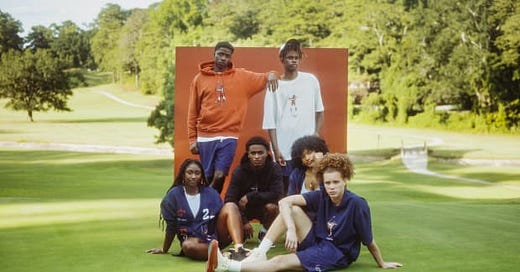Making Golf More Inclusive Through Fashion & Culture...
With Tiger Woods near retirement and golf’s largest player segment being an aging demographic. Golf needs to find ways to attract a younger and diverse audience to save it from being a dying sport....
Happy new week,
Black British adults make just a 1.7% share of the total golfers playing and in America only 3% of recreational golfers are black. Tiger Woods serves as a huge inspiration to many by becoming the first black golfer in history to win one of professional golf’s major championships but there’s still no black British golfer yet to make their mark on the game and only a four black American golfers hold PGA Tour status.
Golf is still seen as highly elitist and not a welcoming or inclusive environment for black people. The golf course isn’t a space where black people see themselves, therefore it’s not seen as a place to relax and connect, it’s seen as a place where they would be an outsider. In the wake of George Floyd’s murder in 2020, 80 sporting governing bodies in the UK, including England Golf, released a statement that they will do more to confront racism and make meaningful change but still so few black people play golf.
There are a number of barriers to entry when it comes to participating in golf. The high costs for golf equipment, membership and tournament fees act as a huge barrier to entry and unless you have a sponsor it's hard to pursue a professional career as a golfer. With golf usually not played in inner cities there is a lack of proximity to areas where black people usually tend to live and congregate, which makes it more difficult for them to engage with golf.
The structural barriers to entry apply to a lot of people in general but the structural barriers as well as the cultural barriers make it extremely difficult for people from the black community to participate. Golf lacks cultural relevance and to attract more black golfers, the governing bodies and organisations have to change their approach.
Lifestyle golf brand, Eastside Golf, founded by Olajuwon Ajanaku and Earl Cooper in 2019, is a brand created to make golf welcoming to black youth and non golfers. The brand has become a staple worn by such notable golf enthusiasts as Barack Obama, DJ Khaled, Dwyane Wade, and CC Sabathia and has collaborated with the likes of Jordan Brand, the NBA, Apple, and Mercedes-Benz USA.
Olajuwon and Earl were both teammates on Morehouse College’s golf team, helping them win a national championship in 2010. Upon graduating, Cooper went on to become a Class-A PGA pro, then one of the best instructors in the country. Ajanaku wanted to pursue his dreams of turning pro. After trying unsuccessfully to acquire sponsorship for a few years, he decided to put his accounting degree to use and took a job in finance.
Eastside Golf is making the game more appealing to a younger and more diverse audience. The brand being championed by the likes of Jordan and other influential brands gives them a platform to reach more people but the responsibility of diversifying golf shouldn’t fall on people like Ajanaku and Cooper. Golf institutions are responsible for making the sport more inclusive and accessible, which they are doing through targeted diversity initiatives and outreach programmes but I believe they need to dig deeper and truly understand that their current culture is their worst enemy.
For golf to reverse its current declining trend, it has to find ways to attract a younger and diverse audience especially as its largest player segment (55-65) is aging and there’s a pressing need to ensure its longevity. At Divrse Media, we truly believe by integrating culture, meeting communities where they are, and creating bespoke experiences that resonate with a younger, more diverse audience you can create a more inclusive space increasing participation from this audience.



